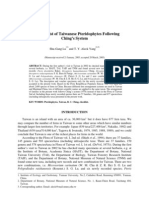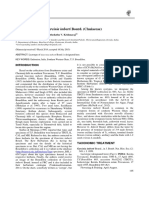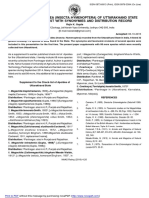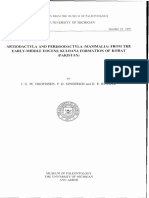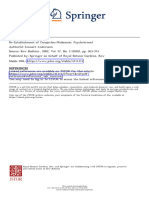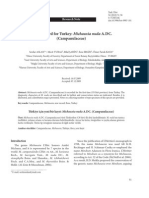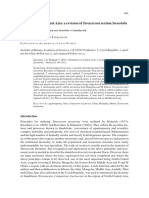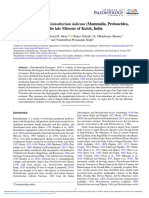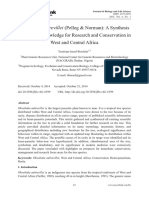Professional Documents
Culture Documents
The Liverwort (Lejeuneaceae) Long-Lost in India Rediscovered
Uploaded by
Raisa AzhariOriginal Title
Copyright
Available Formats
Share this document
Did you find this document useful?
Is this content inappropriate?
Report this DocumentCopyright:
Available Formats
The Liverwort (Lejeuneaceae) Long-Lost in India Rediscovered
Uploaded by
Raisa AzhariCopyright:
Available Formats
Acta Botanica Hungarica 53(3–4), pp.
283–289, 2011
DOI: 10.1556/ABot.53.2011.3–4.10
THE LIVERWORT THYSANANTHUS SPATHULISTIPUS
(LEJEUNEACEAE) LONG-LOST IN INDIA
REDISCOVERED
A. E. D. DANIELS1, K. C. KARIYAPPA1 and P. DANIEL2
1
Bryology Laboratory, Botany Department and Research Centre, Scott Christian College
(Autonomous), Nagercoil–629 003, Tamil Nadu, India
2
36, Arulnagar, Nagercoil–629 001, Tamil Nadu, India
(Received 9 February, 2011; Accepted 30 May, 2011)
The liverwort Thysananthus spathulistipus, earlier known to be distributed in the Eastern
Himalaya, Northeast India and the Andamans in India, has been rediscovered in the Western
Ghats after more than a century. It was last collected by Decoly and Schaul in Kurseong in
1898. A detailed description of the species, an illustration and a distribution map are provided.
Key words: Peninsular India, rediscovered, Thysananthus spathulistipus, Western Ghats
INTRODUCTION
The genus Thysananthus Lindenb. belonging to the family Lejeuneaceae
has ca 10 species in the world (Gradstein 1992) and 2, viz., T. gottschei (J. B. Jack
et Steph.) Steph. and T. spathulistipus (Reinw., Blume et Nees) Lindenb. in India
(Bapna et Kachroo 2000, Parihar et al. 1994). Mitten (1861) who first reported T.
spathulistipus from India based on a Griffith material from the Khasia Hills,
once part of the colonial Assam, did so under the name Lejeunea spathulistipa
(Reinw. et al.) Dumort. Subsequently, Verdoorn (1934) who included T. spa-
thulistipus cited the Griffith material referred to above and added another ma-
terial collected by E. H. Man in 1890 in the Andaman (and Nicobar) Islands, an
archipelago in the Indian Ocean and cut off from the Indian mainland by a dis-
tance of about 1,200 km.
While exploring the erstwhile Tirunelveli-Travancore Hills, now a part of
the Agasthyamalai Biosphere Reserve in the southern Western Ghats for a
bryoflora, material of this species was collected at Pandimotta in Kollam Dis-
0236–6495/$ 20.00 © 2011 Akadémiai Kiadó, Budapest
284 DANIELS, A. E. D., KARIYAPPA, K. C. and DANIEL, P.
trict in Kerala, which is a rediscovery of the species in the Western Ghats in
Peninsular India. Though our primary objective is to bring out an inventory of
bryophytes of the southern Western Ghats eventually, one of the secondary
objectives is to identify/recollect the endemic and rare species particularly
those not collected after the British botanists during the colonial era. In an ear-
lier paper we reported the rediscovery of the liverwort Schistochila aligera
(Nees et Blume) J. B. Jack et Steph. (Daniels and Daniel 2008). Here we report
the rediscovery of Thysananthus spathulistipus made after more than a century.
With a view to facilitating its rediscovery elsewhere and fixing its status, this
species is described in detail, illustrated and its distribution in India mapped.
Thysananthus spathulistipus (Reinw., Blume et Nees) Lindenb.
Basionym: Jungermannia spathulistipa Reinw., Blume et Nees (1824), Nova Acta
Phys.-Med. Acad. Caes. Leop.-Carol. Nat. Cur. 12: 212; Sprengel (1827), Syst. Veg. 4(1): 222,
No. 67; Nees (1830), Hepat. Jav.: 38, No. 48. ≡ Lejeunea spathulistipa (Reinw., Blume et Nees)
Dumort. (1835), Recueil Observ. Jungerm. 1: 12; Mitten (1861), J. Proc. Linn. Soc., Bot. 5: 109;
Spruce (1885), Trans. Proc. Bot. Soc. Edinburgh 15: 106. ≡ Frullania spathulistipa (Reinw.,
Blume et Nees) Nees (1838), Naturgesch. Eur. Leberm. 3: 211. ≡ Phragmicoma spathulistipa
(Reinw., Blume et Nees) Mitten (1871), Seemann: Fl. Vit., p. 412. ≡ Thysananthus spathulistipus
(Reinw., Blume et Nees) Lindenb. in Gottsche et al. (1845), Syn. Hepat., p. 287; Jack et
Stephani (1894), Bot. Centralbl. 60(4): 104; Schiffner (1898), Consp. Hepat. Arch. Ind., p. 307,
No. 386; Verdoorn (1934), Ann. Bryol. (Suppl.) 4: 167; Mizutani (1969), J. Hattori Bot. Lab.
32: 138; Campbell (1971), J. Roy. Soc., New Zealand 1: 13; Kitagawa (1973), J. Hattori Bot.
Lab. 37: 271; Onraedt (1985), Cryptog. Bryol. Lichénol. 6: 173; Thiers and Gradstein (1989),
Mem. New York Bot. Gard. 52: 71; Parihar et al. (1994), Hepat. Anthocerot. India, p. 38;
Grolle (1995), Bryophyt. Biblioth. 48: 139; Srivastava (1998), Topics Bryol., p. 72; Bapna and
Kachroo (2000), Hepatic. India 2, p. 292; Gradstein et al. (2002), Acta Bot. Fenn. 174: 80;
Piippo et al. (2002), Ann. Bot. Fenn. 39: 120; Wigginton (2002), Trop. Bryol. Res. Rep. 3: 73. –
Type: Indonesia, Java, Bantam, Leback. Coll.: Blume, s.n. (Holotype: STR; isotypes: G, W).
(Figs 1–18).
= Lejeunea ungulata Mitten (1861), J. Proc. Linn. Soc., Bot. 5: 110. – Type: Burma, Rangoon.
Coll.: McClelland, s.n. (BM).
= Thysano-lejeunea amboinensis Schiffner (“1889” 1890), Forschungsreise S. M. S. “Gazelle” 4:
22. – Type: Indonesia, Amboina (FH).
= Thysananthus sikkimensis Steph. ex [Schiffner (1899), Österr. Bot. Zeitschr. 49: 205, No. 30,
nom. nud.] Stephani (1912), Sp. Hepat. 4: 798. – Types: India, (Sikkim-) Himalaya,
prope Kurseong, 6,000 ft. Coll.: Rev. P. Decoly and Schaul, s.n., 28 March 1889
(Schiffner No. 516), Bryoth. E. Levier (NY); (Bhutan), “zwischen Maria Basti & Labar,
5,000–6,000 ft”. Coll.: Rev. L. Durel (159), 12 April 1898, Herb. Levier. (G).
= Thysananthus aculeatus Herzog (1931), Ann. Bryol. 4: 89; Mizutani (1969), J. Hattori Bot.
Lab. 32: 137. – Type: Philippines, Mt Banahaom C. Luzon. Coll.: Baker (7079/7083), 12
Dec. 1913 (BM).
= Thysananthus fuscobrunneus Horik. (1934), J. Sci. Hiroshima Univ., Ser. B, Div. 2, Bot. 2: 251.
– Type: Taiwan, Mt Chipon, Prov. Taitô. Coll.: Horikawa (10505), Dec. 1932 (HIRO).
Acta Bot. Hung. 53, 2011
THYSANANTHUS SPATHULISTIPUS LONG-LOST IN INDIA REDISCOVERED 285
Figs 1–18. Thysananthus spathulistipus (Reinw. et al.) Lindenb. – 1 = plant, 2 = cross section of
stem, 3–4 = leaves, 5 = leaf apical cells, 6 = leaf median cells, 7 = leaf basal cells, 8 = cells with
oilbodies, 9 = leaf lobule teeth, 10–12 = underleaves, 13 = male inflorescence, 14–15 = female
bracts, 16 = female bracteole, 17 = perianth, 18 = cross section of perianth (1–18 from K. C.
Kariyappa 15)
Acta Bot. Hung. 53, 2011
286 DANIELS, A. E. D., KARIYAPPA, K. C. and DANIEL, P.
Plants monoicous, corticolous, pendant, 3–5 cm long, olive green. Stems
with branching of Frullania-type, pinnate or bipinnate, 0.14–0.18 µm in diam.,
with 12–15 cells across; cortical cells thick-walled, non-trigonous, quadrate-
hexagonal, 4–20 × 4–8 µm; medullary cells with walls thinner than that of corti-
cal ones, non-trigonous, quadrate-hexagonal, 8–20 × 8–12 µm. Leaves incubous,
wide-spreading, 1.2–1.5 × 0.56–0.8 mm, oblong-ovate, asymmetric, cordate at
base, acute and toothed at apex; margin widely arched dorsally, incurved ven-
trally; keel arched; cells thick-walled, with bulging trigones and intermediate
nodular thickenings; apical and marginal cells 6–8 × 4–6 µm; median ones
20–40 × 12–20 µm; basal ones 28–48 × 16–20 µm; oil bodies 3–8 per cell, seg-
mented, 6–12 × 2–4 µm, ovoid to spindle-shaped; lobules ca 1/3 as long as
leaves, rectangular, 2-toothed at apex; teeth distinct, 3- or 4-celled. Under-
leaves imbricate, transversely inserted, not appendiculate, roughly cuneate,
irregularly denticulate at margin above, sometimes faintly 2-lobed, recurved
at lateral margin, 3–4 times as broad as stem, 0.64–1.12 × 0.56–0.96 mm, smaller
towards base and larger towards female inflorescences. Male inflorescences
terminal on lateral branches, 1.5–3 mm long; bracts 8–12, smaller than leaves,
0.35–0.4 × 0.25–0.32 mm, toothed at apex; lobules swollen, many-toothed;
bracteoles imbricate, smaller than underleaves, 0.55–0.7 × 0.15–0.25 mm,
toothed at margin above. Female inflorescences terminal on main stem or
branches, with subfloral innovations; bracts larger than leaves, 1.5–2 × 0.9–1.1
mm, oblong-ovate, toothed at margin above; lobules ovate-oblong, 0.7–0.9 ×
0.4–0.6 mm, toothed; bracteoles twice as long as underleaves, 1.5–1.8 × 0.7–0.9
mm, lingulate, inflexed and undulate at margin above, slightly bifid at apex.
Perianth 1.5–1.7 × 0.7–0.9 mm, oblong, inflated, 3-keeled; keels toothed.
Sporogonium seen immature.
Habitat: Corticolous, in evergreen forests, ca 200 m.
Distribution: Tropics. India: Andamans, Eastern Himalaya (W Bengal),
NE India (Meghalaya) and Western Ghats (Fig. 19).
Specimens examined: Kerala, Kollam District, Westren Ghats, Shankili
Forest, Pandimotta, ca 200 m. Coll.: K. C. Kariyappa (15), 02.06.2009. Herb.
Scott Christian College, Nagercoil (SCCN).
DISCUSSION
Emilio Levier (1839–1911) bought specimens from many collectors and
afterwards sold them to museums and other collectors under “Bryotheca E.
Levier” with about 2,400 specimens (Winter, in litt.). Schiffner (1899) based on
material collected by Rev. R. Durel on 12 April 1898 in “British-Bhutan” be-
tween Maria Basti and Labar, which he had received from his Italian friend the
Acta Bot. Hung. 53, 2011
THYSANANTHUS SPATHULISTIPUS LONG-LOST IN INDIA REDISCOVERED 287
said Levier, listed 35 liverworts including T. sikkimensis without a description,
but with remarks on its affinity with allied species and attributed the name to
Stephani. He also mentioned in the paper that F. Stephani had a nice collection
from Kurseong (in Sikkim). Schiffner had found that some plants of the Durel
collection and those from Stephani were the same. As he anticipated Stephani
to publish these, Schiffner mentioned such plants only by their manuscript
names. Long (1979) discussed the issue of Durel not having collected in the
so-called British-Bhutan and pointed out that Schiffner (1899) wrongly as-
sumed so as may be evident from the title of his paper and that these areas are
near Kalimpong (Darjeeling District) in the State of West Bengal in India.
Stephani (1912) validly published the name T. sikkimensis, which is con-
sidered a synonym of T. spathulistipus by recent workers. In the protologue
Stephani (1912) mentioned only “Hab. Himalaya” concerning a type. How-
ever, the microfiche of the unpublished icones of Stephani (image 10212) men-
tions Herb. Levier. and the Decoly and Schaul material at NY, which was re-
ceived from G has information such as India (Sikkim-) Himalaya, prope Kur-
Fig. 19. Distribution of Thysananthus spathulistipus in India (l earlier localities; ª present lo-
cality)
Acta Bot. Hung. 53, 2011
288 DANIELS, A. E. D., KARIYAPPA, K. C. and DANIEL, P.
seong and Bryotheca Levier to boot. Since the material at G and NY came from
the same source “Bryotheca E. Levier” it is reasonable to assume that they are
original material.
Granting that Durel was the last to collect material of T. spathulistipus (= T.
sikkimensis) in 1898, the present collection, made in the Western Ghats far away
from the earlier known region at the other end of the country and a totally dif-
ferent phytogeographical region, is indeed an interesting rediscovery of this
species after more than a century, 112 years to be exact. Though this species is
said to be distributed in the tropics and somewhat common in other regions
(vide Specimens examined in Onraedt 1985, Piippo et al. 2002, Thiers and
Gradstein 1989), it appears to be rare in India.
*
Acknowledgements – The senior author is thankful to the Ministry of Environment and
Forests, Govt. of India, New Delhi, for funding a project under the AICOPTAX and to Dr M.
Sanjappa, former Director, Botanical Survey of India, Kolkata, for encouragement and a
copy of D. G. Long’s paper. The authors are thankful to the Kerala State Forest Department
for permission to explore the area in question and help in the field, Dr R. L. Zhu (HSNU), for
confirming the identity of the material, Mr M. J. Wigginton (Peterborough, England) and Dr
X.-L. He (Botanical Museum, University of Helsinki, Finland), for help with literature, to Dr
G. Winter (Senckenberg Natural History Museum, Germany), for help with literature, in-
formation on image 10212 in the microfiche of Stephani’s unpublished icones, on the labels
of the material of T. sikkimensis at G and NY and unravelling the E. Levier connection and Dr
M. Price (G), for information on the label of T. sikkimensis material at G. The senior author is
thankful to Dr S. C. Rose (Principal, Scott Christian College), for encouragement.
REFERENCES
Bapna, K. R. and Kachroo, P. (2000): Hepaticology in India. 2. – Himanshu Publ., New Delhi,
India.
Campbell, E. O. (1971): Liverworts collected in Fiji by A. C. Smith and W. Greenwood. – J.
Roy. Soc. New Zealand 1: 7–30.
Daniels, A. E. D. and Daniel, P. (2008): The liverwort Schistochila aligera (Nees et Blume) J.
B. Jack et Steph. (Schistochilaceae) rediscovered in India. – Cryptog. Bryol. 29: 307–310.
Gottsche, C. M., Lindenberg, J. B. G. and Nees von Esenbeck, C. G. (1845): Synopsis
Hepaticarum. (1844–1847) – Meissner, Hamburg, Germany.
Gradstein, S. R. (1992): The genera Thysananthus, Dendrolejeunea and Fulfordianus gen.
nov. (Studies on Lejeuneaceae subfamily Ptychanthoideae XXI). – Bryologist 95: 42–51.
Gradstein, S. R., He, X.-L., Piippo, S. and Mizutani, M. (2002): Bryophyte flora of the Huon
Peninsula, Papua New Guinea. LXVIII. Lejeuneaceae subfamily Ptychanthoideae
(Hepaticae). – Acta Bot. Fenn. 174: 1–88.
Grolle, R. (1995): The Hepaticae and Anthocerotae of the East African Islands: an annotated
catalogue. – Bryophyt. Biblioth. 48: 1–178.
Acta Bot. Hung. 53, 2011
THYSANANTHUS SPATHULISTIPUS LONG-LOST IN INDIA REDISCOVERED 289
Jack, J. B. and Stephani, F. (1894): Hepaticae in insulis Vitiensibus et Samoanis a Dre Ed.
Graeffe anno 1864 lectae. – Bot. Centralbl. 60: 97–109.
Kitagawa, N. (1973): Miscellaneous notes on little known species of Hepaticae, 26–50. – J.
Hattori Bot. Lab. 37: 263–273.
Long, D. G. (1979): Hepaticae from Bhutan, East Himalaya. – Lindbergia 5: 54–62.
Mitten, W. (1861): Hepaticae Indiae Orientalis. – J. Proc. Linn. Soc. Bot., Suppl. 5: 89–128.
Mitten, W. (1871): Jungermanniae and Marchantiae. – In: Seemann, B. (ed.): Flora Vitiensis. L.
Reeve and Co., London, UK, pp. 325–453.
Mizutani, M. (1969): Lejeuneaceae subfamily Ptychanthoideae from Sabah (North Borneo).
– J. Hattori Bot. Lab. 32: 129–139.
Onraedt, M. (1985): Bryophytes de Sri Lanka VII. Lejeuneaceae Holostipae. – Cryptog. Bryol.
Lichénol. 6: 151–175.
Parihar, N. S., Lal, B. and Katiyar, N. (1994): Hepatics and Anthocerotes of India. A new anno-
tated checklist. – Central Book Depot, Allahabad, India.
Piippo, S., He, X.-L., Juslén, A., Tan, B. C., Murphy, D. H. and Pócs, T. (2002): Hepatic and
hornwort flora of Singapore. – Ann. Bot. Fenn. 39: 101–127.
Schiffner, V. (1898): Conspectus Hepaticarum Archipelagi Indici. – Botanischer Garten in
Buitenzorg, Staatsdruckerei Batavia, Batavia (Jakarta).
Schiffner, V. (1899): Beiträge zur Lebermoosflora von Bhutan (Ost-Indien). – Österr. Bot.
Zeitschr. 49: 127–132, 203–207.
Spruce, R. (1885): Hepaticae Amazonicae et Andinae. – Trans. Proc. Bot. Soc. Edinburgh 15:
1–582.
Srivastava, S. C. (1998): Distribution of Hepaticae and Anthocerotae in India. – In: Chopra, R. N.
(ed.): Topics in bryology. Allied Publ. Ltd., New Delhi, India, pp. 53–84.
Stephani, F. (1912): Species Hepaticarum. Vol. 4. (1910–1912). – George et Cie., Génčve, Swit-
zerland.
Thiers, B. M. and Gradstein, S. R. (1989): Lejeuneaceae (Hepaticae) of Australia. I. subfamily
Ptychanthoideae. – Mem. New York Bot. Gard. 52: 1–81.
Verdoorn, F. (1930): De Frullaniaceae der Indomalesischen Inseln (De Frullaniaceis VII). –
Ann. Bryol., Suppl. 1: 1–187.
Verdoorn, F. (1934): Studien über Asiatiche Jubuleae (De Frullaniaceis XV–XVII). Mit einer
Einleitung. Bryologie und Hepatologie, ihre Methodik und Zukunft. – Ann. Bryol.,
Suppl. 4: 1–231.
Wigginton, M. J. (2002): Checklist and distribution of the liverworts and hornworts of
sub-Saharan Africa, including the East African Islands. – Trop. Bryol. Res. Rep. 3: 1–88.
Acta Bot. Hung. 53, 2011
You might also like
- New record of violet crab from West IndiaDocument6 pagesNew record of violet crab from West IndiaMithila BhatNo ratings yet
- Hoya PusillaDocument5 pagesHoya PusillaHisyamNo ratings yet
- Hemionitis Formosana (Hayata) Christenh.A New Record To The: Pteridophyticflora of Rajasthan, IndiaDocument6 pagesHemionitis Formosana (Hayata) Christenh.A New Record To The: Pteridophyticflora of Rajasthan, IndiaTJPRC PublicationsNo ratings yet
- 9 Taiwanese PteridophytesDocument29 pages9 Taiwanese PteridophytessellaginellaNo ratings yet
- Handout Instrumen IrDocument2 pagesHandout Instrumen IrelkaNo ratings yet
- Plant Science Today: Genus Notoscyphus Mitt. - New To The Liverwort Flora of The Eastern GhatsDocument3 pagesPlant Science Today: Genus Notoscyphus Mitt. - New To The Liverwort Flora of The Eastern Ghatsmendal sciNo ratings yet
- Tectaria 1Document10 pagesTectaria 1dominicrajkumar1No ratings yet
- Ardiyani 2019Document19 pagesArdiyani 2019MUHAMAD LUTHFID ANANDO ALY ROZANo ratings yet
- 1020 2793 3 PBDocument40 pages1020 2793 3 PBTeguh MuslimNo ratings yet
- Andrographis Nallamalayana, A Heterotypic Synonym of A Little-Known Endemic Species A. Beddomei (Acanthaceae)Document8 pagesAndrographis Nallamalayana, A Heterotypic Synonym of A Little-Known Endemic Species A. Beddomei (Acanthaceae)KhalijahNo ratings yet
- References On Parasitic Weeds of SugarcaneDocument8 pagesReferences On Parasitic Weeds of SugarcaneGunasridharan LakshmananNo ratings yet
- Supplement To Apoidea (Insecta Hymenoptera) of Uttarakhand StateDocument1 pageSupplement To Apoidea (Insecta Hymenoptera) of Uttarakhand StateJournal of Environment and Bio-SciencesNo ratings yet
- Volume 1, Issue 1 (2014) Tropical Plant ResearchDocument30 pagesVolume 1, Issue 1 (2014) Tropical Plant ResearchTropPlResNo ratings yet
- A Taxonomic Note On Impatiens Disotis Hooker, 1906 (Family: Balsaminaceae)Document4 pagesA Taxonomic Note On Impatiens Disotis Hooker, 1906 (Family: Balsaminaceae)anon_534718533No ratings yet
- 2013 Newspeciesof Yaginumaellafrom IndiaDocument5 pages2013 Newspeciesof Yaginumaellafrom IndiaAneesh MathewNo ratings yet
- FT 2Document587 pagesFT 2Alexandru Sabin BadarauNo ratings yet
- Artiodactyla and PerissodactylaDocument30 pagesArtiodactyla and PerissodactylaKalangiIrushikaNo ratings yet
- Ipomoea AitoniiDocument3 pagesIpomoea Aitoniiparamesh lingalaNo ratings yet
- A Revision of The Family Engraulidae (Pisces) From TaiwanDocument11 pagesA Revision of The Family Engraulidae (Pisces) From TaiwanTheresa Marie ErmejeNo ratings yet
- PASSIFLORACEAEDocument7 pagesPASSIFLORACEAEEmilio Lecaros BustamanteNo ratings yet
- 2002_Re-Establishment of CarapicheaDocument13 pages2002_Re-Establishment of CarapicheamariangelestmNo ratings yet
- Discovering Robert Wight's Vanda Wightii Rchb. F PDFDocument6 pagesDiscovering Robert Wight's Vanda Wightii Rchb. F PDFSathish KumarNo ratings yet
- 6 Pachyteria - PromaliaDocument5 pages6 Pachyteria - PromaliaAmitava MajumderNo ratings yet
- Plant Collections From Bangladesh in The Herbarium at Shillong (Assam), India.Document26 pagesPlant Collections From Bangladesh in The Herbarium at Shillong (Assam), India.López LuisNo ratings yet
- A New Record For Turkey: Michauxia NudaDocument6 pagesA New Record For Turkey: Michauxia NudaSerdar AslanNo ratings yet
- Ursa in South America (Araneae: Araneoidea) : The Spider Genera Heterognatha, Testudinaria andDocument14 pagesUrsa in South America (Araneae: Araneoidea) : The Spider Genera Heterognatha, Testudinaria andJose Miguel TovarNo ratings yet
- Article: ZootaxaDocument17 pagesArticle: ZootaxaJulian LeonardoNo ratings yet
- Taurus Rhaponticoides HierroiDocument11 pagesTaurus Rhaponticoides HierroiAlexandru Sabin BadarauNo ratings yet
- AcrolejeuneameghalayensisDocument5 pagesAcrolejeuneameghalayensisSugey Ortiz-SerranoNo ratings yet
- Lissemys PunctataDocument12 pagesLissemys PunctataMaharani Putri ChaniaNo ratings yet
- Studies On The Genus Tectaria Cavanilles (Dryopteridaceae - Pteridophyta) of Western Ghats of KarnatakaDocument8 pagesStudies On The Genus Tectaria Cavanilles (Dryopteridaceae - Pteridophyta) of Western Ghats of Karnatakadominicrajkumar1No ratings yet
- Reptile Rap #07 (Aug 2005)Document12 pagesReptile Rap #07 (Aug 2005)ReticulatusNo ratings yet
- THAI FOREST BULLETIN NOTES ON TWO IXORA SPECIESDocument140 pagesTHAI FOREST BULLETIN NOTES ON TWO IXORA SPECIESBiotropicsNo ratings yet
- E9163 e 1 ADocument6 pagesE9163 e 1 ALuthfi Nur AlwiNo ratings yet
- B Công Anh TQDocument22 pagesB Công Anh TQNhoctocngan TrangNo ratings yet
- Kerala Reptile Survey Finds Rare Turtle SubspeciesDocument12 pagesKerala Reptile Survey Finds Rare Turtle SubspeciesReticulatusNo ratings yet
- A Filmy Fern: Crepidomanes Latealatum (Bosch) Copel. New To Northern Western Ghats of IndiaDocument3 pagesA Filmy Fern: Crepidomanes Latealatum (Bosch) Copel. New To Northern Western Ghats of IndiaFernando DuranteNo ratings yet
- Balfour Browne 1968 Fungi of Recent Nepal Expeditions 0001Document46 pagesBalfour Browne 1968 Fungi of Recent Nepal Expeditions 0001Lázaro TeoNo ratings yet
- Peristylus BalakrishnaniiDocument3 pagesPeristylus BalakrishnaniiSumathi RamamurthyNo ratings yet
- 1726-Article Text-3169-1-10-20191207Document10 pages1726-Article Text-3169-1-10-20191207Annisa RahmadaniNo ratings yet
- Shi 2015Document13 pagesShi 2015cristopher jimenez orozcoNo ratings yet
- The First Specimen of Deinotherium IndicDocument8 pagesThe First Specimen of Deinotherium IndicDeepak ChoudharyNo ratings yet
- New Five Species of The Myxomycetes Recorded From The South-East Egion of Maharashtra (India)Document4 pagesNew Five Species of The Myxomycetes Recorded From The South-East Egion of Maharashtra (India)Umesh MogleNo ratings yet
- Field Guide to Trees of Kaundinya Wildlife SanctuaryDocument75 pagesField Guide to Trees of Kaundinya Wildlife SanctuaryRahul ChitnisNo ratings yet
- Cicada of SundalandDocument60 pagesCicada of SundalandMaximillian HeartwoodNo ratings yet
- New Combinations in Thai FernsDocument7 pagesNew Combinations in Thai FernsruddhasenNo ratings yet
- Lejeuneaceae) - An Addition To The Indian Bryoflora From Andaman & Nicobar IslandsDocument6 pagesLejeuneaceae) - An Addition To The Indian Bryoflora From Andaman & Nicobar IslandsRaisa AzhariNo ratings yet
- Thysananthus fruticosus - An Addition to Indian BryofloraDocument6 pagesThysananthus fruticosus - An Addition to Indian BryofloraRaisa AzhariNo ratings yet
- 2017 - Yañez Et. AlDocument18 pages2017 - Yañez Et. AlGugú YáñezNo ratings yet
- 3 2002232Ng241360Document21 pages3 2002232Ng241360Juba chabaneNo ratings yet
- Karanovi - Et Al-2015-Nordic Journal of BotanyDocument14 pagesKaranovi - Et Al-2015-Nordic Journal of BotanyAndressa PelozoNo ratings yet
- HybanthusstellarioidesDominP I ForsterViolaceae-anewrecordDocument3 pagesHybanthusstellarioidesDominP I ForsterViolaceae-anewrecordKurumbapatty Zoolagical ParkNo ratings yet
- MaterialesDocument16 pagesMaterialesJason EspitiaNo ratings yet
- OkuobakaDocument29 pagesOkuobakaEricsson BotchweyNo ratings yet
- Saddle Peak New ReportsDocument3 pagesSaddle Peak New ReportsSumathi RamamurthyNo ratings yet
- The Cyatheaceae of PeruDocument35 pagesThe Cyatheaceae of PerudavidNo ratings yet
- Soliva Anthemifolia PDFDocument3 pagesSoliva Anthemifolia PDFSandeepNo ratings yet
- Identification and Description of Copulatory Complex in Tarsotrechus Polhemi Anderson, 1980Document3 pagesIdentification and Description of Copulatory Complex in Tarsotrechus Polhemi Anderson, 1980Kanhiya MahourNo ratings yet
- Studies On The Genus 3. Terpenoid Chemistry and Chemotaxonomy of Selected Species of Thysananthus and Dendrolejeunea FruticosaDocument11 pagesStudies On The Genus 3. Terpenoid Chemistry and Chemotaxonomy of Selected Species of Thysananthus and Dendrolejeunea FruticosaRaisa AzhariNo ratings yet
- Coretan MasihDocument6 pagesCoretan MasihRaisa AzhariNo ratings yet
- Torrey Botanical Society Journal Article on Revision of the Genus ThysananthusDocument12 pagesTorrey Botanical Society Journal Article on Revision of the Genus ThysananthusRaisa AzhariNo ratings yet
- Lejeuneaceae) - An Addition To The Indian Bryoflora From Andaman & Nicobar IslandsDocument6 pagesLejeuneaceae) - An Addition To The Indian Bryoflora From Andaman & Nicobar IslandsRaisa AzhariNo ratings yet
- Thysananthus fruticosus - An Addition to Indian BryofloraDocument6 pagesThysananthus fruticosus - An Addition to Indian BryofloraRaisa AzhariNo ratings yet
- Pembahasan Soal UN Kimia SMA 2008 PDFDocument11 pagesPembahasan Soal UN Kimia SMA 2008 PDFyuniputriNo ratings yet
- Ovozoa Vol. 8, No. 2, Oktober 2019 ISSN: 2302-6464Document5 pagesOvozoa Vol. 8, No. 2, Oktober 2019 ISSN: 2302-6464Raisa AzhariNo ratings yet
- 10.1007@s11696 020 01192 4Document7 pages10.1007@s11696 020 01192 4Raisa AzhariNo ratings yet
- Orbital: Jurnal Pendidikan Kimia: Website: Jurnal - Radenfatah.ac - Id/index - Php/orbitalDocument10 pagesOrbital: Jurnal Pendidikan Kimia: Website: Jurnal - Radenfatah.ac - Id/index - Php/orbitalRaisa AzhariNo ratings yet
- Pone 0218195Document20 pagesPone 0218195Raisa AzhariNo ratings yet
- Pone 0218195Document20 pagesPone 0218195Raisa AzhariNo ratings yet
- 10 1016@j Geoderma 2019 114122Document9 pages10 1016@j Geoderma 2019 114122Raisa AzhariNo ratings yet
- 10 1016@j Geoderma 2019 114122Document9 pages10 1016@j Geoderma 2019 114122Raisa AzhariNo ratings yet
- 141 303 3 PBDocument7 pages141 303 3 PBFeby BalqisNo ratings yet
- Blastocystis Sp. To Treat or Not To Treat. 2012Document6 pagesBlastocystis Sp. To Treat or Not To Treat. 2012Nico RochaNo ratings yet
- Goals and Fields of Psychology in 40 CharactersDocument45 pagesGoals and Fields of Psychology in 40 Charactersmuhammad umerNo ratings yet
- Ribosomes - Protein Construction Teams: RibosomeDocument2 pagesRibosomes - Protein Construction Teams: RibosomeIs SianNo ratings yet
- The Hunt For A Healthy Microbiome: OutlookDocument3 pagesThe Hunt For A Healthy Microbiome: OutlookLindo PulgosoNo ratings yet
- Histology of GangliaDocument18 pagesHistology of GangliaTahir AzizNo ratings yet
- 〈90〉 Fetal Bovine Serum-Quality Attributes and Functionality TestsDocument4 pages〈90〉 Fetal Bovine Serum-Quality Attributes and Functionality Testsmehrdarou.qaNo ratings yet
- Lab Manual - Cell Biology - SBC3013 PDFDocument35 pagesLab Manual - Cell Biology - SBC3013 PDFAiman JohorNo ratings yet
- Banasthali Vidyapith: Internal Research SupervisorsDocument10 pagesBanasthali Vidyapith: Internal Research SupervisorsasanyogNo ratings yet
- Costa Et Al., 2008Document11 pagesCosta Et Al., 2008Angel LaraNo ratings yet
- Medical TerminologyDocument14 pagesMedical TerminologyAdi SomersetNo ratings yet
- SWSC2 - Learning Outcome 1Document9 pagesSWSC2 - Learning Outcome 1Marcela Coid100% (2)
- Cost Effective Submarine Electrophoresis ApparatusDocument3 pagesCost Effective Submarine Electrophoresis ApparatusRanadive AnanthNo ratings yet
- Genetic AlgorithmDocument23 pagesGenetic AlgorithmGanga SagarNo ratings yet
- Exchange Surfaces Summary SheetDocument1 pageExchange Surfaces Summary Sheetrobgardner1No ratings yet
- Part - 1 - Circulatory - System - 1.ppt Biology 2Document11 pagesPart - 1 - Circulatory - System - 1.ppt Biology 2RekaNo ratings yet
- Guidance Technical Documentation and Design Dossiers Fornon Active Medical DevicesDocument25 pagesGuidance Technical Documentation and Design Dossiers Fornon Active Medical DevicesCamila CamposNo ratings yet
- Westerhof, In, 2009: Medical History and Physical Examination in Companion Animals (Second Edition)Document3 pagesWesterhof, In, 2009: Medical History and Physical Examination in Companion Animals (Second Edition)Jeriel Baton SeguidoNo ratings yet
- Epa 841 B 99 002 Hidrobiologia PDFDocument344 pagesEpa 841 B 99 002 Hidrobiologia PDFfredy perezNo ratings yet
- Quiz 2 Fetal DevelopmentDocument1 pageQuiz 2 Fetal DevelopmentDENNIS N. MUÑOZNo ratings yet
- B.inggris Report TextDocument3 pagesB.inggris Report TextseryxNo ratings yet
- Kmab 14 2111748Document20 pagesKmab 14 2111748bilou hertNo ratings yet
- Early-Onset Neonatal Sepsis 2014Document27 pagesEarly-Onset Neonatal Sepsis 2014Ninde Rivera GonzalezNo ratings yet
- Uncommon Amino Acid: Aileen C. Olantigue BSN - 1B 1:00pm - 7pmDocument3 pagesUncommon Amino Acid: Aileen C. Olantigue BSN - 1B 1:00pm - 7pmAshley Niño Jun AtuelNo ratings yet
- BNMNS B370205Document8 pagesBNMNS B370205James PerianayagamNo ratings yet
- Food Web InterpretationDocument3 pagesFood Web InterpretationanaNo ratings yet
- To Study The Transverse Section of Clove BudsDocument3 pagesTo Study The Transverse Section of Clove Budspooja arya100% (1)
- 148-Article Text-565-1-10-20211005Document11 pages148-Article Text-565-1-10-20211005sri wahyundari manikNo ratings yet
- Ecosystems as Complex SystemsDocument35 pagesEcosystems as Complex SystemsFelix Arthur Dioso100% (1)
- Placenta Previa NCP 1Document6 pagesPlacenta Previa NCP 1Nicole ArandingNo ratings yet
- FUNGI SOMATIC STRUCTURES AND ASEXUAL REPRODUCTIONDocument36 pagesFUNGI SOMATIC STRUCTURES AND ASEXUAL REPRODUCTIONDevesh KumarNo ratings yet





